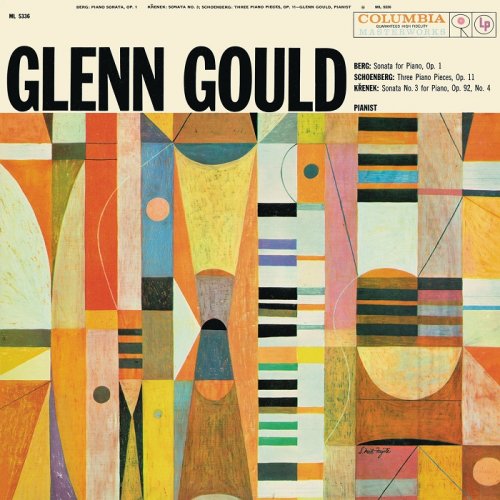Glenn Gould - Berg, Schoenberg, Krenek: Piano Sonatas (1959/2015) [HDTracks]

Artist: Glenn Gould
Title: Berg, Schoenberg, Krenek: Piano Sonatas
Year Of Release: 2015 (1959)
Label: Columbia, Sony Classical
Genre: Classical, Piano
Quality: FLAC (tracks) [24Bit/44,1kHz]
Total Time: 48:18
Total Size: 403 MB (d.booklet)
WebSite: Album Preview
Title: Berg, Schoenberg, Krenek: Piano Sonatas
Year Of Release: 2015 (1959)
Label: Columbia, Sony Classical
Genre: Classical, Piano
Quality: FLAC (tracks) [24Bit/44,1kHz]
Total Time: 48:18
Total Size: 403 MB (d.booklet)
WebSite: Album Preview
Glenn Gould could not have timed his professional entrance to the recording studio any better than with his première recording in 1955. Five years had passed since the lacquer disc medium had been retired and the industry had fully embraced tape recording.
The availability of digital tools for remastering and restoration has never been greater, or more refined. Yet everything starts with the original masters. Columbia Records kept very good archives of session logs, documenting which takes were recorded on which job reel, and to which musical work they belong. Gould often worked with the producer on choosing how the takes would be edited together, marking directly in the score where one take would end and the next would begin. The session reels were assembled into a “master edit reel.” If the master edit reel was mono or stereo, it would go directly to mastering, where the proper EQ (equalization) was applied for generating a “vinyl master.” If the master edit was three-track or higher, a master stereo mix would be made; this might be a generation before the vinyl master, should further vinyl EQ be necessary for LP manufacturing. Thankfully, the archives have preserved previous generations, so today we can ignore the numerous later copies and work with the original master edits.
In the remastering studio, we maintain original analogue Studer A80, A820 and A807 machines for playback of the Gould recordings. Most of these machines are modified by JRF Magnetics in order to ensure perfect reading from the playback head stack. The signal is converted to DSD via Mytek digital converters, all the while being monitored through Bowers & Wilkins Nautilus 802 series speakers (powered by Krell 600 watt amplification). This level of professional playback ensures that we hear exactly what was recorded at the studio without coloration and with greater clarity than even Glenn Gould had heard. The audio is treated in the computer using Cube-Tec restoration tools when needed, tools that allow us to remove such noises as electrical tics, pops, random studio noises, or even electrical buzzing.
Now, in 2015, we have accomplished a project that took more than three years: the analogue (and digital) remastering of Gould’s entire recorded legacy for Columbia. Remastering and restoration is not, however, a process of creating something new, but the art of bringing clarity and enhancement to the original masterpiece. Just as the restoration of the Sistine Chapel brought new life to Michelangelo’s paintings, so we’ve tried to bring new life to Glenn Gould’s recordings.
The availability of digital tools for remastering and restoration has never been greater, or more refined. Yet everything starts with the original masters. Columbia Records kept very good archives of session logs, documenting which takes were recorded on which job reel, and to which musical work they belong. Gould often worked with the producer on choosing how the takes would be edited together, marking directly in the score where one take would end and the next would begin. The session reels were assembled into a “master edit reel.” If the master edit reel was mono or stereo, it would go directly to mastering, where the proper EQ (equalization) was applied for generating a “vinyl master.” If the master edit was three-track or higher, a master stereo mix would be made; this might be a generation before the vinyl master, should further vinyl EQ be necessary for LP manufacturing. Thankfully, the archives have preserved previous generations, so today we can ignore the numerous later copies and work with the original master edits.
In the remastering studio, we maintain original analogue Studer A80, A820 and A807 machines for playback of the Gould recordings. Most of these machines are modified by JRF Magnetics in order to ensure perfect reading from the playback head stack. The signal is converted to DSD via Mytek digital converters, all the while being monitored through Bowers & Wilkins Nautilus 802 series speakers (powered by Krell 600 watt amplification). This level of professional playback ensures that we hear exactly what was recorded at the studio without coloration and with greater clarity than even Glenn Gould had heard. The audio is treated in the computer using Cube-Tec restoration tools when needed, tools that allow us to remove such noises as electrical tics, pops, random studio noises, or even electrical buzzing.
Now, in 2015, we have accomplished a project that took more than three years: the analogue (and digital) remastering of Gould’s entire recorded legacy for Columbia. Remastering and restoration is not, however, a process of creating something new, but the art of bringing clarity and enhancement to the original masterpiece. Just as the restoration of the Sistine Chapel brought new life to Michelangelo’s paintings, so we’ve tried to bring new life to Glenn Gould’s recordings.
Tracklist:
Alban Berg (1885-1935)
1 Piano Sonata No. 1: Mässig bewegt 13:08
Arnold Schoenberg (1874-1951)
Drei Klavierstücke, Op. 11
2 I. Mässig 04:10
3 II. Mässige 08:25
4 III. Bewegt 02:33
Ernst Křenek (1900-1991)
Sonata for Piano No. 3, Op. 92 No. 4
5 I. Allegretto piacavole, animato e flessibile 04:46
6 II. Theme, Canons and Variations. Andantino - Agitato - Allegretto 06:55
7 III. Scherzo - Vivace ma non troppo 01:33
8 IV. Adagio 06:48
*************************
Glenn Gould - piano
![Glenn Gould - Berg, Schoenberg, Krenek: Piano Sonatas (1959/2015) [HDTracks]](https://img.israbox.com/uploads/posts/2017-12/1513826704_download.jpg)




![Afrodream - Guiss Guiss (2025) [Hi-Res] Afrodream - Guiss Guiss (2025) [Hi-Res]](https://www.dibpic.com/uploads/posts/2025-12/1765638325_a2717494732_0.jpg)
![RAS - Rød i Blå (2025) [Hi-Res] RAS - Rød i Blå (2025) [Hi-Res]](https://www.dibpic.com/uploads/posts/2025-12/1765847447_s09xuo23tcu1a_600.jpg)


